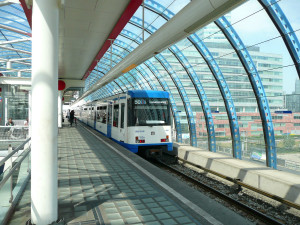Light Rail, Metro or Tram? …Some definitions from the International Association of Public Transport (UITP)…
Metro: “an urban guided electric transport system with high capacity and frequency of service, running mostly on rails on an exclusive right-of-way without any interference from other traffic or level crossings and mostly with some degree of drive automation and train protection. These design features allow high capacity trains to run with short head-ways and high commercial speed. Metros are therefore suitable for the carriage of high passenger flows. In some countries they are also known as the underground, subway or tube.“
Light Rail: “rail-borne form of transport which can be developed in stages from a modern tramway to a rapid transit system operated on its own right-of-way, underground, at ground level or elevated“.

Metro designs tend to permit a higher overall speed and passenger throughput than light rail or tram systems, and require higher capital investment. Light Rail may be distinguished from a Tram system in that it operates on its own dedicated line, segregated from other modes of transport and pedestrians: Light Rail does not operate on shared road space with other vehicles as might be the case with a Tram. In practice, the vehicles for Light Rail and Tram systems might be similar or even identical (see e.g. the Bombardier Flexity Light Rail Vehicle and the Alstom Citadis Light Rail Vehicles).
Adopting the UITP definitions, Cambridge Connect believes Light Rail is the appropriate scale and form of technology to meet Cambridge needs. According to the UITP Light Rail is the ideal mode for carrying between 3000 and 11 000 passengers per hour per direction, which appears similar to initial calculations of capacity requirements for Cambridge. The Docklands Light Railway can carry more than this, so we can be completely confident that a light rail system for Cambridge is future-proofed. We anticipate that Cambridge Light Rail would operate underground and at ground level mostly on its own right-of-way. Cambridge Light Rail could operate as a Tram sharing streetspace in some places (this is not envisaged within the historic city core, where the network would be underground), and this would be determined in detailed technical designs.







